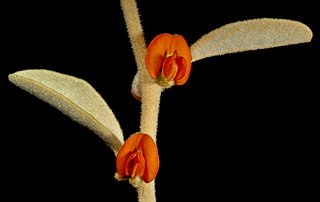
Tephrosia is a genus of flowering plants in the family Fabaceae. It is widespread in both the Eastern and Western Hemisphere, where it is found in tropical and warm-temperate regions.

Tephrosia purpurea is a species of flowering plant in the family Fabaceae, that has a pantropical distribution. It is a common wasteland weed. In many parts it is under cultivation as green manure crop. It is found throughout India and Sri Lanka in poor soils.

Tephrosin is rotenoid. It is a natural fish poison found in the leaves and seeds of Tephrosia purpurea and T. vogelii.
Fish toxins or fish stupefying plants have historically been used by many hunter gatherer cultures to stun fish, so they become easy to collect by hand. Some of these toxins paralyse fish, which can then be easily collected. The process of documenting many fish toxins and their use is ongoing, with interest in potential uses from medicine, agriculture, and industry.

Tephrosia virginiana, also known as goat-rue, goat's rue, catgut, rabbit pea, Virginia tephrosia, hoary pea, and devil's shoestring is a perennial dicot in family Fabaceae. The plant is native to central and eastern North America.

Ectropis is a genus in the geometer moth family (Geometridae). They are mostly paleotropical, but also plentiful in Australia and extend into Asia. Only one species – or cryptic species complex – is found in Europe. There are about 100 known species in this genus.

Eupalitin is an O-methylated flavonol. It can be found in Ipomopsis aggregata.

Barbigerone is one of a few pyranoisoflavones among several groups of isoflavones. It was first isolated from the seed of a leguminous plant Tephrosia barbigera; hence the name "barbigerone". Members of the genus Millettia are now known to be rich in barbigerone, including M. dielsiena, M. ferruginea, M. usaramensis, and M. pachycarpa. It has also been isolated from the medicinal plant Sarcolobus globosus. Barbigerone from S. globosus is validated to have significant antioxidant property. Barbigerone exhibits profound antiplasmodial activity against the malarial parasite Plasmodium falciparum. It is also demonstrated that it has anti-cancer potential as it causes apoptosis of murine lung-cancer cells.
Tephrosia clementii is a plant species, endemic to the north-west of Western Australia. It is an annual with a prostrate, spreading habit, growing to between 0.1 and 0.25 metres high. Orange or red flowers are produced between January and March in the species' native range.

Tephrosia rosea, commonly known as Flinders River poison, is a plant species, endemic to northern Australia. It is a shrub with an erect or sprawling habit, growing to between 0.2 and 2 metres high. Pink to purple flowers are produced throughout the year in the species' native range.

The tribe Millettieae is one of the subdivisions of the plant family Fabaceae.
Dichomeris acuminata, the alfalfa leaf tier, is a moth of the family Gelechiidae. It was first described by Otto Staudinger in 1876. It is a widely distributed species, being known from India, Myanmar, and Sri Lanka southwest to the Seychelles, Mauritius and Réunion and on to Egypt, east and South Africa and southern Europe. Eastward from India it extends through Indonesia and Malaysia to Taiwan and Australia. It is also found in Japan, the West Indies, North America and Hawaii.

Tephrosia vogelii, the Vogel's tephrosia, fish-poison-bean or Vogel tephrosia (English), tefrósia (Portuguese) or barbasco guineano (Spanish), is a flowering plant species in the genus Tephrosia.
Mesophleps ioloncha is a moth of the family Gelechiidae. It is found in India, Sri Lanka, Thailand, China, Taiwan, Indonesia, the Solomon Islands and the Philippines.

Tephrosia apollinea is a legume species, native to southwest Asia and northeast Africa.

Tephrosia elongata is a plant native to Africa south of the equator. It occurs from northern and eastern South Africa to the highlands of Malawi and Tanzania.

Tephrosia candida, the white hoarypea, is a perennial shrub, native to India, in the legume family. It has been introduced to Malesia, South America, Africa, South East Asia and Australia.

Tephrosia glomeruliflora, or pink tephrosia, is a perennial (non-climbing) herb in the family Fabaceae, endemic to South Africa. It is also found on the eastern coast of Australia, in New South Wales and Queensland, where it is considered an environmental weed.

Tephrosia arenicola is a plant in the Fabaceae family, native to the north of Western Australia. The species has no synonyms.















